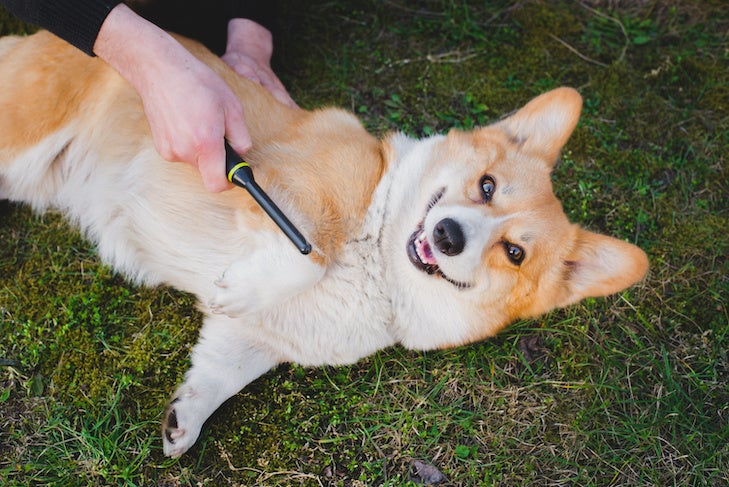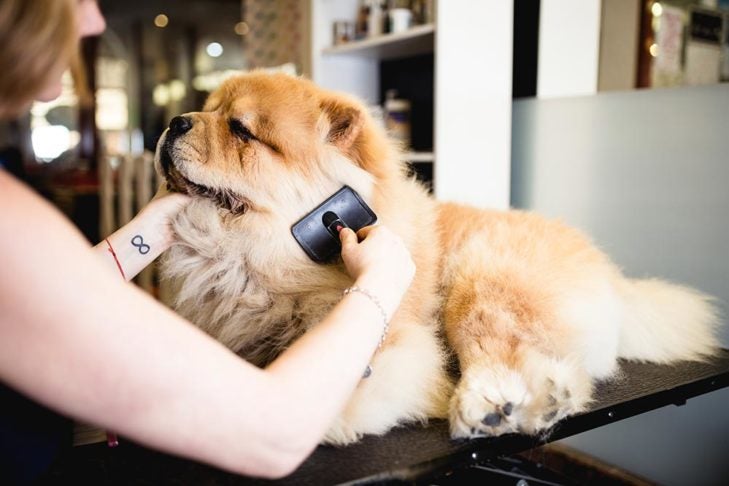
AKC is a participant in affiliate advertising programs designed to provide a means for sites to earn advertising fees by advertising and linking to akc.org. If you purchase a product through this article, we may receive a portion of the sale.
Warmer weather typically means spending more time outdoors with your dog. These grooming tips will help keep your dog feeling cool and comfortable. As a bonus, they will also enhance the relationship you have with your pet.
“Grooming is one of nature’s strongest ways of bonding,” says Jorge Bendersky, a certified master groomer and best-selling author. “It’s a way to show our love.” Even if you have a designated groomer, there are things you can do at home between visits.
Brushing Your Dog
There are lots of obvious benefits associated with brushing your dog regularly, from reduced shedding to having a cleaner coat. But you may not know that it’s a great way to keep a dog cool while also giving you the chance to spot any irregularities on their skin, like infections or allergies or fleas and ticks. Meg Marrs, founder and CEO of K9 of Mine, says, “Regular brushing will work out any mats that may have developed in your dog’s coat. Mats are troublesome in the summer, as they trap moisture from the humidity and irritate your pooch’s skin.” Regular brushing also removes dead hair and helps circulation on the outer layer of skin.
Time Required to Brush Your Dog
The amount of time you’ll spend brushing depends on your dog’s coat. Double-coated dogs, such as the Golden Retriever, Old English Sheepdog, Yorkshire Terrier, and Shih Tzu often require additional time. “The undercoat is softer and usually of a different texture, which requires extra attention,” explains Bendersky.
More hair on a bigger dog doesn’t necessarily mean more time. Bendersky points out that an Afghan Hound that is brushed regularly will probably take less time than a Pekingese that hasn’t been brushed in weeks.
Teach Your Dog to Like Grooming
Certified behaviorist and Los Angeles-based dog trainer Russ Hartstein suggests brushing your dog while they’re in all positions — standing, sitting, and lying down — to condition them. If your dog doesn’t like being touched, especially in sensitive spots, offer a reward as a way to create a positive experience.
Young dogs that will need to have their coats clipped may be afraid of the noise and vibrations. Running a child-size electric toothbrush gently through a puppy’s coat can help them get accustomed to those sensations.
Start doing this slowly. Hold one of the tools you’re using in one hand while gently petting your dog with the other. If your dog is curious, allow them to sniff the tool. You can offer a treat, so they begin to associate the grooming tools with something positive.
When brushing, start off with small, gentle strokes in a spot where your dog likes to be touched. As you begin to brush, praise your pup, keeping them in a relaxed state. From here, you can work your way up to longer strokes. If you notice that your dog is uncomfortable, allow them to move away. Getting a dog used to being groomed can take time, since it is a discipline for both of you.
Use the Right Tools
Different breeds also have different grooming needs. It is a process that must be done properly and with the right tools and methods. Bendersky recommends that owners who have dogs with a double coat use a slicker brush and a wide-tooth comb, while dogs with a single coat can be safely brushed with a pin brush and a comb.

Bathing Your Dog
Not all dogs enjoy getting a bath, so giving yours one might not be as easy as you hope. Luckily, dogs don’t require the same type of grooming schedule as we do, and a daily bath is not necessary or even good for the dog. But when it comes to washing your pup, there are some important pointers to follow to make bath time a safe and positive experience.
Remove Dead Hair and Mats First
Get rid of dead hair and mats before bathing your dog. Brush your dog first and/or use a wet-dry brush designed to be used when the shampoo makes their coat easier to brush out.
Work From the Neck Down
Be careful of your dog’s eyes, ears, and mouth. Use a damp cloth to clean your pup’s face, and when it comes to rinsing, use a cup or handheld sprayer to control the direction of the water.
Prevent Water From Getting in the Ears
One way to ensure water doesn’t get inside your dog’s ears is to place a dry cotton ball carefully at the top of the ear canal. Bendersky points out that a soaked cotton ball will allow water to get in, so changing them out a few times during a bath is a good idea.
He also recommends an ear-cleaning solution be applied before and after bathing — before to clean up any wax and dirt that might have accumulated, and after to change the pH of any humidity left behind, preventing the potential for bacteria to grow. Carefully cleaning and drying your dog’s ears after a bath will prevent a possible infection.
Rinse, Rinse, and Rinse Again
This is the most important step and should take as much time as shampooing. A dog’s skin is not as airtight as a human’s. Where we have one hair for each follicle, a dog can have multiple hairs growing from each hair follicle. “Any product that is not formulated as a leave-on product could penetrate into a deeper layer of skin, causing an irritation that can range from an itch to a chemical burn,” says Bendersky.
Use Dog Shampoo
Because a dog’s skin PH is different than a person’s, it’s important to use a shampoo formulated specifically for dogs. Human shampoo is made to remove the oils from our hair, but with dogs, oils help keep their skin and coat healthy and shiny so we don’t want to remove them. And it’s best to use cool or lukewarm water, never hot.
Avoid Slips and Falls
When you give your dog a bath, place a towel or non-slippery mat on the bottom of the tub or sink, so that your pet won’t slip. Bendersky also suggests keeping a loose leash around your dog in order to give you a little more control if they try to get away.
After the bath, towel dry your dog, especially the paws. “Slippery paws can lead to accidents,” says Bendersky.
Don’t Bathe Your Dog Too Often
Every few weeks or once a month is enough. Frequent bathing can strip away essential oils, making the skin itch and drying out the coat. If you need to clean your dog in-between baths, there are leave-on sprays that condition and clean, and you can use a damp towel to wipe off dirt.

Cutting Your Dog’s Hair
“Dogs can’t sweat the way people do, so their body heat needs external help to get out,” says Lazhar Ichir, founder of Breeding Business. Especially for dogs with longer or thicker hair, you might want to consider a summer haircut to keep them cooler and their fur more manageable.
Your dog’s coat actually acts as an insulator. However, this insulating layer can backfire during continuously hot weather, as it can make it harder for dogs to lower their body temperatures. Without the insulating layer, dogs are susceptible to heat stroke, so don’t shave your dog down to the skin. Besides taking away that insulation, you are making them more susceptible to sunburn.
If it is advisable to help your dog stay cool by giving them a haircut, you can invest in a professional pair of clippers or scissors. When cutting, use only the tips of the scissors to trim the feet, face, and tail. That way, you will avoid accidentally nipping your dog should they make any sudden movements. Leave at least one inch of hair, and be sure to keep the clippers cool. If you need a bit of guidance in this area, consult a professional groomer. Online video tutorials can also walk you through the process.
Clipping Dog Nails
Another essential part of a dog’s basic grooming is regular nail trimming. If you plan to give your pooch a pedicure, make sure you have the right tools, along with styptic powder in case you cut down too close to the quick (an incredibly tender part within the nail).
Whether you plan on using clippers or a nail grinder, getting your dog used to the noise of the tool can make the experience a little easier. “Always make positive associations with any novel piece of equipment and all accompanying sounds, sights, smells, and surfaces,” advises Hartstein.

Most dogs have black nails, making it impossible to see where the quick is from the top of the nail. Trim small bits at a time until you see a solid black dot on the tip, which is when you know you’ve reached the quick. If you accidentally clip too far down, immediately press the styptic powder against the nail to staunch any bleeding. Cutting white nails is a little easier because the quick can be seen from the outside of the nail. Once you see a pink dot at the center, you’ll know you’ve reached it.
If your dog is panting or trying to lick their paws while you’re clipping, these are indicators they’re feeling stressed. Stop right away and give your dog a break.
AKC S.A.F.E Grooming Program
Grooming safety should always be a top priority, whether you’re a professional groomer or a dog owner who performs some of these tasks at home. The American Kennel Club has designed the AKC S.A.F.E. (Safety, Assurance, Fundamentals, Education) Grooming Program to support the grooming industry’s self-regulation effort through education. Classes are given to help professionals cultivate a better understanding of safety measures and protocols within the grooming facility.
Through the AKC GroomerFinder, dog owners can find professionals in their area. And, they have peace of mind knowing their canine companion is in the hands of a professional who values and upholds pet safety. You can contact AKC Groomer Education at groomer@akc.org for more information on AKC S.A.F.E.

